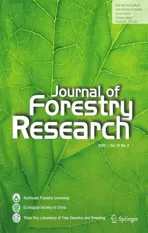Effect of gap size and forest type on mineral nitrogen forms under different soil properties
2020-05-22AleKueraLadislavHolikElenaMuozCerroJanPetek
AlešKučera · Ladislav Holik · Elena Muñoz Cerro · Jan Petříček
Abstract Gaps play a key role in forest ecosystem development and result from either natural processes or targeted forest management activities. The aim of this study was to investigate the interrelationships of soil properties in each of three forest types and two treatments,and to identify factors that influence levels of soil mineral nitrogen forms. The relation between mineral nitrogen and factors of soil parameters and stand type (European beech,Norway spruce, mixed stand) categories were investigated.The spruce forest type stored significant nitrogen in both mineral forms of nitrogen. Moreover, there was a significant linear dependence between (nitrate anion)concentrations and cation exchange capacity (CEC)parameters such as base cation contents (S-CEC) and potential ureolytic activities (UreasePot), as well as between (ammonium cation) concentrations and both hydrolytic acidities (Ha-CEC) and ureolytic activities.The dependence of concentrations on S-CEC contents and UreasePot was negative, especially in adjacent stand. The dependence of concentrations on Ha-CEC and UreasePot was week in the beech and mixed forest types while it was significantly positive in the spruce forest type.
Keywords · Urease · Protease · European beech · Norway spruce
Introduction
Canopy gaps play key roles in forest ecosystem development and result from either natural processes or targeted forest management activities. They significantly affect habitat conditions (D’Oliveira and Ribas 2011; Pang et al.2016) such as nutrient cycling dynamics, thermal flow, site moisture (Li et al. 2017) and light conditions (He et al.2012; Hniličková et al. 2016). These conditions affect soil microbial activities, and gaps contribute in shaping specific microclimate environments, subsequent biological activities, biochemical processes, and energy cycling within the ecosystem (Ritter and Bjørnlund 2005).
Nitrogen availability depends largely on organic matter decomposition by micro biota (Holik et al. 2016) and the conversion of organic nitrogen to its inorganic compounds(Ritter and Bjørnlund 2005). Soil microbes are subjected to microclimate characteristics and are specific for various woody species, i.e., Norway spruce (Picea abies (L.) H.Karst.) and European beech (Fagus sylvatica L.). They are also subjected to a broad range of soil properties (Setiawan et al. 2016).
This study examines the forms and contents of soil mineral nitrogen in gaps and the relation between mineral nitrogen and soil parameters and stand types (European beech, Norway spruce, mixed stand). It is focused on the internal system of gaps which is edaphically determined.
In terms of internally determined relationships within a forest ecosystem, the following questions have been raised:(1) How does forest type, gap size and position of sampling(centre/parental), considered as categorical variables: For-Type (beech/spruce/mix), gap size (small/big) and Position(centre/parental) affect soil parameters, including physicalchemical parameters such as pH, cation exchange capacity(CEC); chemical parameters such as organic carbon as oxidative (Cox), total nitrogen (Nt), C/N ratio, nitrate and ammonium nitrogen (N-NO3-, N-NH4+, respectively);and, biochemical parameters such as protease, urease (both native and potential ureolytic activity-UreaseNat and UreasePot, respectively), catalase activity, microbial carbon (Cmic)?; (2) What are the relationships among soil parameters in the context of categorical variables that focus on forms of mineral nitrogen?; and, (3) Which factors from the group of categorical variables and soil parameters have the largest influence on mineral nitrogen contents in terms of its individual forms (nitrate and ammonium nitrogen)?
Materials and methods
Area description and field work
The research plots (Table 1) were established in the Training Forest Enterprise Masaryk Forest Křtiny (TFE),which is an organizational part of Mendel University in Brno in winter 2013/14. Natural conditions are a slightly undulating topography and altitudes between 520 and 570 m.a.s.l. with an annual precipitation of approximately 610 mm and annual mean temperature of 7.5 °C. The plots are on the border of the Moravian Karst and transition into the lower plateau of the Cretaceous sediments, the so called Rudice Beds.
Plots were numbered from Gap 1 to Gap 6 and situated in three mature stands (95-105 years) of different forest types including beech (ForType-Beech) (Gaps 1 + 2;European beech 100%); mixed (ForType-Mixed) (Gaps 3 + 4; European beech 50%, Norway spruce 50%); and spruce (ForType-Spruce) (Gaps 5 + 6; Norway spruce 100%).
Soil surveys and sampling were performed in autumn 2015. Soil profiles were described for each forest type by determining the soil taxonomic unit and humus form(Table 1). The six gaps (gap size-big/B, and small gaps gap size-small/S) were sampled in the centre of the plots (Position-Centre/C) and in neighbouring forests (Position-Parental/P). In each position, four representative mixed samples were collected, (each sample approximately 500 g from three sites), from the organomineral A horizon. The samples were passed through a 2 mm sieve and stored in PET bags at 5 °C.
Laboratory analyses
Ammonium and nitrate nitrogen levels were determined according to Kučera et al. (2013), i.e., N expressed in terms of the relevant form of mineral nitrogen. Soil pH was measured in suspensions of soil: water and soil: 1 M KCl at a ratio of 1:2.5 (Zbiral and Honsa 2010). Hydrolytic acidity(Ha-CEC) and base cation content (S-CEC) were assessed in sodium acetate and hydrochloric acid, respectively(Lityński et al. 1976), and used to count base saturation(BS-CEC) from S-CEC and cation exchange capacity (TCEC). Organic carbon was assessed as oxidative carbon(Cox) by sulphochromic oxidation (Zbiral and Honsa 2010). Total nitrogen (Nt) was determined according to Zbiral and Honsa (2010). Soil catalase activity was measured manometrically using O2production (Gömöryova et al. 2009); soil protease activity was measured spectrophotometrically based on casein hydrolysis of the substrate, and the amount of L-tyrosine produced was measured (Rejsek et al. 2008). Urease activity was determined spectrophotometrically according to Kandeler and Gerber (1988); the amount of released ammonium nitrogen was determined after the soil samples were incubated with urea. Protease activity was measured as native; urease activity was measured as both potential and native. The methodology for protease and urease activity was adjusted(Rejsek et al. 2008), specifically, demineralised water was added instead of a buffer. The determined protease and urease activity was so-called native; enzyme activity was limited by soil pH instead of by the pH of the added buffer.The determination of microbial biomass carbon was performed using a fumigant extraction method. In the presence of strong sulphuric acid, the organic matter is oxidized and Cr(VI) is reduced to Cr(III). The loss of Cr(VI) was determined spectrophotometrically (Zbiral and Honsa 2010).
Statistical analysis
The statistical analysis was performed in R software, version 3.2.3 (R Foundation for Statistical Computing). In the regression triplet, (data, model, method), the data were observed using boxplots and an ordination method of data projection within the ‘vegan’ package, version 2.3-5 (Oksanen et al. 2016). To observe the next relations among variables, correlation analysis used the ‘pairs’ function.
Linear regression was performed using a generalized linear model (GLM) with a ‘gamma’ error distribution and a natural logarithm link function, where E [y|x,z] =exp(α + β·x + γ·z) =. The data were tested to verify the dependence of (y ~)andconcentrations using continuous variables such as the soil properties from the groups of physical-chemical, chemical and biochemical, and categorical variables (i.e., ‘ForType’,‘Position’ and ‘Gap size’), tested both with and without interactions. Graphics were created using the ‘ggplot2’package, version 2.1.0 (Wickham and Chang 2016). The final model was selected using Akaike′s information criterion (AIC), variance inflation factors (VIF) and p value when alpha = 0.05.
Results
In terms of the parameters considered, the individual stands and their canopy gaps are soil-specific (Tables 2, 3).Overall mineral nitrogen content was highest in ForType-Spruce compared to beech and mixed forest types and had higher average contents of both nitrate N (significantly)and ammonium N (more balanced with ForType-Beech), as well as a higher proportion of mineral nitrogen Nminin total nitrogen Nt.
Principal Component Analysis (PCA) (Fig. 1) shows the relationships between the individual variables and ForType position in factorial plane. ForType-Beech is determined particularly by soil enzymatic activity and related physical-chemical properties. ForType-Mixed is determined by two variables: C/N ratio and T-CEC with strong positive correlation and significance for the second PCA component. ForType-Spruce is bound to the mineral nitrogen fraction, Coxand Cmiccontent (Fig. 2).

Table 2 Characteristics of soil properties grouped in categorical variables
Discussion
The canopy gaps led to an accelerated decomposition of organic matter, as well as to mineralization leading to an increase of available nutrients which can be utilized by plants or microbial biomass (Muscolo et al. 2014).

Table 3 Characteristics of soil properties grouped in categorical variables ForType and position
The assessment of causes in changes or differences inandcontent is subject to a comprehensive approach considering more aspects from the soil properties categories but also within the forest stand context and litter characteristics of the relevant ForType.
Urease, as a constitutive enzyme (Gobat et al. 2010), is a result of prolonged soil chemistry when, under long-term nitrate presence, ureolytic activity involved in N uptake in ammonium form is reduced. If nitrogen is present in the soil, albeit in the form of nitrate, soil biota are not ‘‘driven’’to energy-consuming biochemical processes of urea decomposition (Xu et al. 2015). This is more striking in parental treatment than in the gap centres. Increasing the availability ofcan suppress nitrite reductase synthesis or inhibittransport into cells (Hart et al.1994); therefore,concentration increases in the soil.
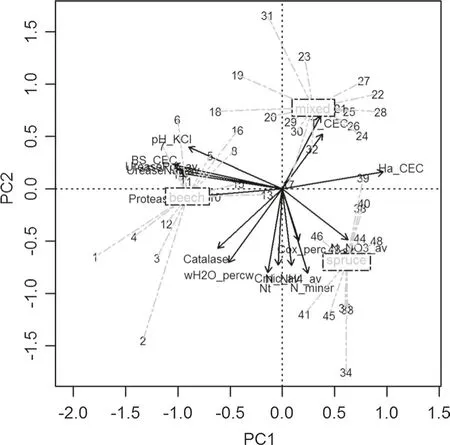
Fig. 1 Ordination plot of soil parameters in projection together with ForType
In several studies, enzymatic activities showed immediate changes in soil properties as a result of felling, as well as from natural regeneration processes (Alvear et al. 2005;Muscolo et al. 2015; Settineri et al. 2018). The reaction of microbial activity results from disturbances, including changes in abiotic conditions, namely temperature and moisture and consequently, changes in form and amount of available nitrogen and in the C/N ratio (Armas et al. 2009).The influence of abiotic conditions on microbial activities were described in detail by Hortal et al. (2015) who reported an increase of enzyme activities (dehydrogenase,β-glucosidase, urease, phosphatase), and also changes in microbial community composition.
Our results have shown increased enzymatic activities in the beech and mixed forest soils (with the exception of UreasePot). Similar results were described by Muscoloet al. (2007a) in European beech and silver fir stands in middle gap sizes (410 m2), and by Muscolo et al. (2007b)for black pine stands with small gap sizes (380 m2) as well as large gap sizes (1520 m2). Settineri et al. (2018) also observed increased protease and catalase activities in comparison with soils in clearcuts with parental stand. An exception was acid phosphatase and cellobiohydrolase activities (Mayer et al. 2017) in large gaps (1000 m2) of a mixed forest type where the activities decreased.

Fig. 2 Results of correlation analysis of soil parameters: with correlation coefficient below diagonal (higher values of correlation coefficient correspond with larger numbers), and histograms of data distribution on the diagonal(pH/KCl is soil reaction exchangeable; Ha-CEC is hydrolytic acidity; S-CEC is base cation content; BS-CEC is base saturation; andare ammonium and nitrate nitrogen, respectively;catalase, protease, UreasePot are enzymatic activity)
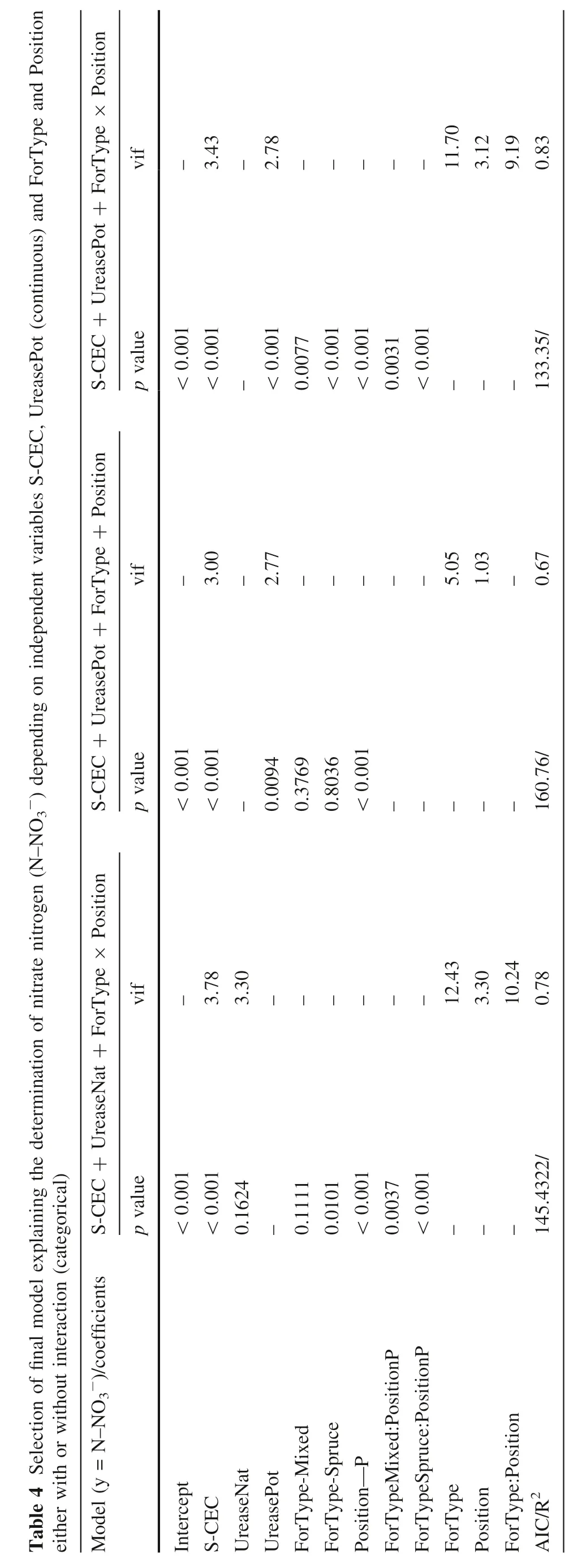
-) depending on independent variables S-CEC, UreasePot (continuous) and ForType and Position S-CEC + UreasePot + ForType × Position vif -3.43-2.78-----11.70 3.12 9.19 0.83 p value<0.001<0.001-<0.001 0.0077<0.001<0.001 0.0031<0.001---133.35/S-CEC + UreasePot + ForType + Position vif -3.00-2.77-----5.05 1.03-0.67 Table 4 Selection of final model explaining the determination of nitrate nitrogen (N-NO3 p value<0.001<0.001-0.0094 0.3769 0.8036<0.001-----160.76/-vif 3.78 3.30------12.43 3.30 10.24 0.78 either with or without interaction (categorical)S-CEC + UreaseNat + ForType × Position p value<0.001<0.001 0.1624-0.1111 0.0101<0.001 0.0037<0.001---145.4322/-)/coefficients Model (y = N-NO3 Intercept S-CEC UreaseNat UreasePot ForType-Mixed ForType-Spruce Position-P ForTypeMixed:PositionP ForTypeSpruce:PositionP ForType Position ForType:Position 2 AIC/R
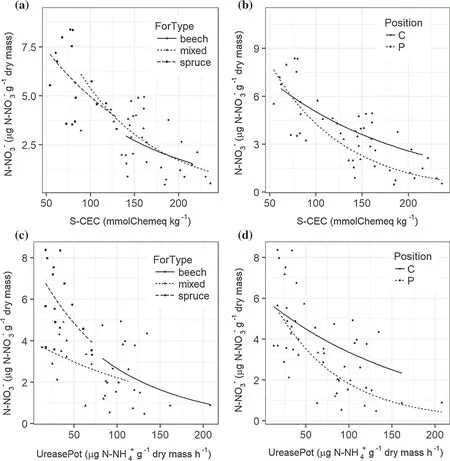
Fig. 3 dependence on S-CEC in function of ForType(a), position (b) and on UreasePot in function of ForType (c), position (d)
Gap size has an immediate effect on the rate of change in microclimatic and edaphic conditions (Zhang and Zak 1995; Ferreira De Lima 2005; Gálhidy et al. 2006; He et al.2015). The selection system is an optimal forest management system in terms of species diversity and microclimate stability (Brunet et al. 2010). However, in terms of harvest practice, it is not always possible to apply this method; the limit of 15-30 trees (Parsons et al. 1994) is considered a cutting-area size. In our case, this means that no significant nitrogen losses occur: the gap sizes fluctuate on a range of small and medium size classes in the case of small gaps,and big size class in case of the big gaps. Only N-NO3-in relation to gap size shows irregular fluctuations and dynamics with no obvious trend.
Changes in nitrate concentrations in soils do not necessarily have to be related to the selected management system, to gap size, or to subsequent changes in microclimatic conditions (Prescott et al. 2003). Changes may be due to the nature of the litter that results from the stand type, or to the harvest itself.
The differences in treatment position correspond to the biological aspects of the tree layer and its effect on the soil water regime. However, some authors report different results, e.g., gaps at the micro-site scale show a determined disturbance and a biological water pump deprivation(Araga~o 2012), and these constitute the initiation factor or subsequent changes in biological and enzymatic activities,humus ratios, soil chemistry and other parameters,including water regime and soil aeration (Guntinas et al.2012; Olajuyigbe et al. 2012). Thus, changes in the significance of nitrogen transformations can be expected in gaps, especially in terms of significantly increased moisture(cf., Tables 2, 3), when both nitrates are transferred to the ammonium form in the process of dissimilatory nitrate reduction to ammonium or when, during the denitrification process, they are converted to a gaseous form (van Groenigen et al. 2015).
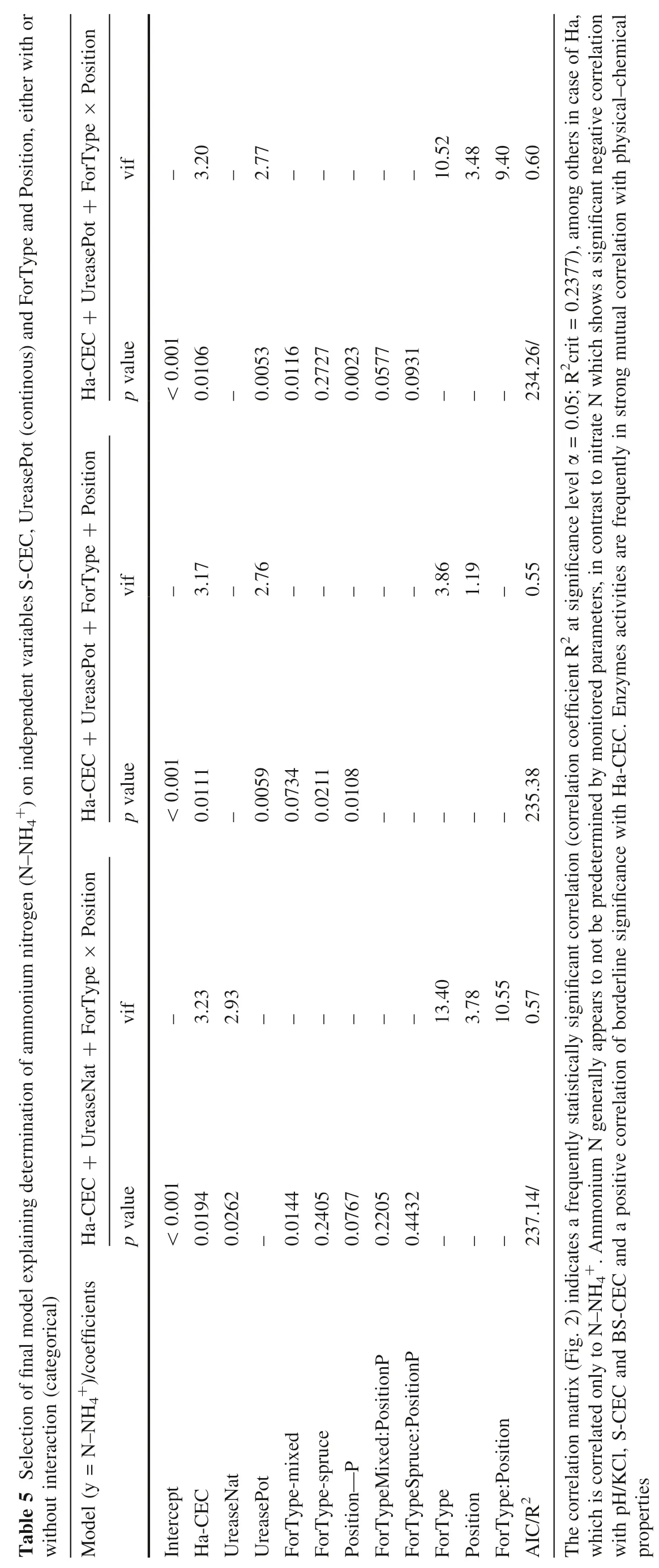
+) on independent variables S-CEC, UreasePot (continous) and ForType and Position, either with or Ha-CEC + UreasePot + ForType × Position vif -3.20-2.77-----10.52 3.48 9.40 0.60 p value<0.001 2crit = 0.2377), among others in case of Ha,0.0106-0.0053 0.0116 0.2727 0.0023 0.0577 0.0931---234.26/Ha-CEC + UreasePot + ForType + Position vif -3.17-2.76-----3.86 1.19-0.55 2 at significance level α = 0.05; R Table 5 Selection of final model explaining determination of ammonium nitrogen (N-NH4 p value<0.001 0.0111-0.0059 0.0734 0.0211 0.0108-----235.38 Ha-CEC + UreaseNat + ForType × Position vif -3.23 2.93------13.40 3.78 10.55 0.57 p value<0.001 0.0194 0.0262-0.0144 0.2405 0.0767 0.2205 0.4432---237.14/+. Ammonium N generally appears to not be predetermined by monitored parameters, in contrast to nitrate N which shows a significant negative correlation without interaction (categorical)+)/coefficients Model (y = N-NH4 Intercept Ha-CEC UreaseNat UreasePot ForType-mixed ForType-spruce Position-P ForTypeMixed:PositionP ForTypeSpruce:PositionP ForType Position ForType:Position 2 AIC/R The correlation matrix (Fig. 2) indicates a frequently statistically significant correlation (correlation coefficient R which is correlated only to N-NH4 with pH/KCl, S-CEC and BS-CEC and a positive correlation of borderline significance with Ha-CEC. Enzymes activities are frequently in strong mutual correlation with physical-chemical properties

Fig. 4 dependence on Ha-CEC in function of ForType(a), position (b) and on UreasePot in function of ForType (c), position (d)
Conclusion
The concentration of N mineral forms was most affected by three factors from the group of soil parameters, (Ha-CEC and UreasePot for; S-CEC and UreasePot for N--), and two factors from the group of categorical variables (ForType and Position for bothand N-). In our study, gap size was not a significant factor.
AcknowledgementsThis work was supported by the Faculty of Forestry and Wood Technology, Mendel University, Brno (IGA Mendelu in Brno ‘‘GAPS’’ 84/2013; IGA Mendelu in Brno LDF_PSV_2017006), and the Ministry of Agriculture of the Czech Republic (QJ1320050) and (MZe RO418).
杂志排行
Journal of Forestry Research的其它文章
- Past, present and future of industrial plantation forestry and implication on future timber harvesting technology
- Effects of climate changes on distribution of Eremanthus erythropappus and E. incanus (Asteraceae) in Brazil
- Effects of climate and forest age on the ecosystem carbon exchange of afforestation
- Effect of forest thinning on hydrologic nitrate exports from a Nsaturated plantation
- Floristic analysis and dominance pattern of sal (Shorea robusta)forests in Ranchi, Jharkhand, eastern India
- Population structure, age and growth rates of conifer species and their relation to environmental variables at Malam Jabba,Swat District, Pakistan
